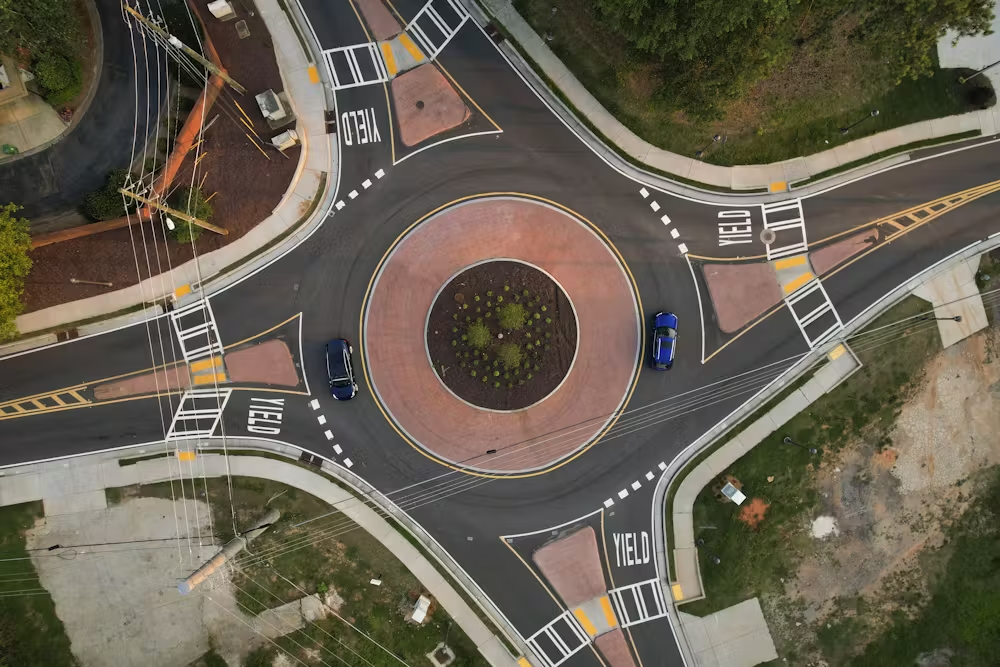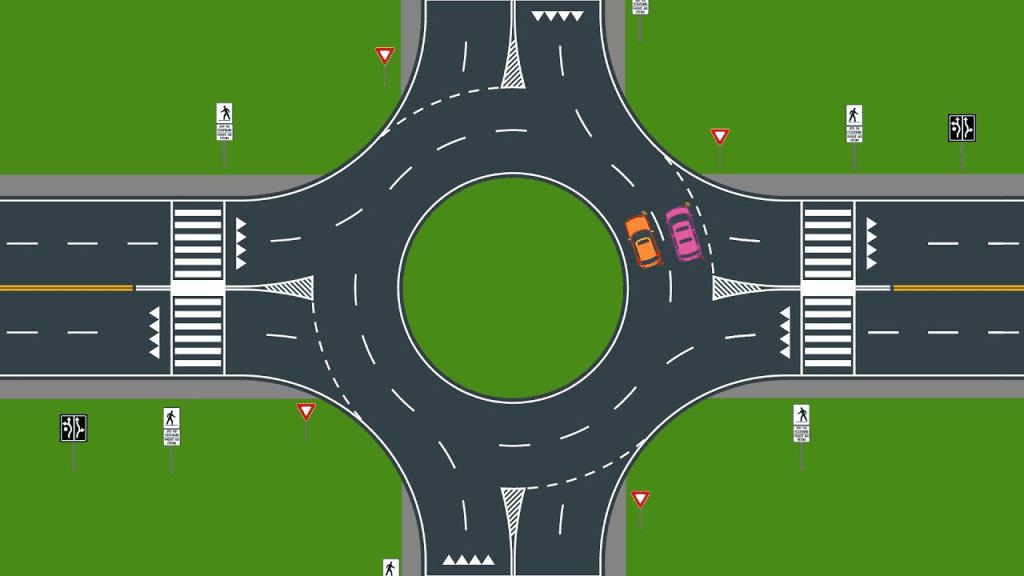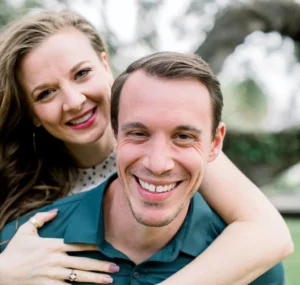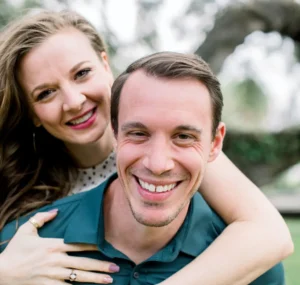If you’ve been driving through U.S. cities and towns, you’ve likely noticed an increase in roundabouts replacing traditional four-way intersections. Some drivers embrace them as an efficient traffic solution, while others find them confusing or even intimidating.
But what exactly is a roundabout, and why is it becoming a preferred alternative to stop signs and traffic signals? Roundabouts are not just about traffic flow—they are a safer, more efficient, and environmentally friendly way to design roads.
Let’s break down what roundabouts are, how they work, and why they are considered one of the most effective traffic management solutions today.
What is a Roundabout? Understanding the Basics

A roundabout—also known as a rotary or traffic circle—is a circular intersection where vehicles move counterclockwise around a central island. Unlike traditional intersections controlled by stop signs or traffic lights, roundabouts operate using a yield-at-entry system, meaning:



Most roundabouts also include:



The result? A smoother, safer, and more efficient intersection that reduces both traffic delays and accidents.
A Brief History of Roundabouts
Many people assume roundabouts are a modern innovation, but their history dates back hundreds of years.
Video : Roundabout Safety Benefits
- 1700s – Early versions of circular intersections appeared in Europe, particularly in England and France.
- 1800s-1900s – Washington, D.C. was designed with multiple traffic circles, inspired by European models.
- 1950s – The United Kingdom introduced the yield-at-entry rule, transforming roundabouts into the efficient system we use today.
- 1990s – The first modern roundabout in the U.S. was built in Summerlin, Nevada in 1990.
- Today – Over 10,000 roundabouts exist in the United States, with more being installed every year.
While roundabouts have been common in Europe and Australia for decades, the U.S. is now rapidly adopting them due to their proven safety and efficiency benefits.
Why Roundabouts Are Safer Than Traditional Intersections
One of the biggest reasons cities are replacing traditional intersections with roundabouts is safety.
1. Fewer Conflict Points = Fewer Accidents
A typical four-way intersection has 32 conflict points—areas where vehicle paths cross, increasing the risk of collisions. In contrast, a roundabout reduces conflict points to just 8.
This means:



According to the Federal Highway Administration (FHWA), roundabouts can reduce serious and fatal crashes by up to 90% when replacing a stop-controlled intersection. Even when replacing a traffic signal intersection, they reduce serious crashes by nearly 80%.
2. Lower Speeds = Less Severe Collisions
In a roundabout, vehicles enter and exit at lower speeds (15-25 mph), compared to the higher speeds (40-50 mph) seen at traditional intersections.
Lower speeds lead to:



3. Safer for Pedestrians and Cyclists

Roundabouts offer better protection for pedestrians because:



With these safety features, roundabouts significantly reduce pedestrian-related accidents compared to traditional intersections.
Efficiency: Why Roundabouts Improve Traffic Flow
Beyond safety, roundabouts are also more efficient than stop signs or traffic lights.
1. Less Waiting, More Moving
At a traditional intersection, cars must stop at red lights, even when there’s no cross traffic. In a roundabout:



2. Eliminating Left Turns = Smoother Flow
One of the most dangerous and disruptive movements at an intersection is the left turn. Roundabouts eliminate left turns, forcing all vehicles to move in the same direction, improving:


3. Roundabouts Handle High Traffic Volumes Better
Unlike stop signs and traffic lights, which cause congestion during peak hours, roundabouts allow continuous movement, making them ideal for high-traffic areas.
Environmental Benefits: How Roundabouts Help the Planet

Roundabouts aren’t just safer and more efficient—they also have environmental advantages.
1. Reduced Fuel Consumption


According to studies, roundabouts can reduce fuel consumption by up to 30%, making them a cost-effective solution for drivers.
2. Lower Carbon Emissions
Fewer stops and starts mean lower emissions, helping reduce air pollution in urban areas. Cities that replace signalized intersections with roundabouts see:


3. Less Road Maintenance Required


With less infrastructure to maintain, roundabouts save cities money in the long run.
Challenges: Why Some Drivers Struggle with Roundabouts
Despite their many benefits, some drivers remain hesitant about roundabouts. Common challenges include:



However, studies show that once drivers become familiar with roundabouts, their confidence improves significantly.
Video : Principles of Intersection Safety
Final Thoughts: Are Roundabouts the Future of Road Design?
Roundabouts are more than just a traffic trend—they are a safer, smarter, and greener solution for modern transportation. With their ability to reduce crashes, improve traffic flow, and lower emissions, they are quickly becoming a preferred alternative to traditional intersections.



As more states adopt roundabouts in urban and suburban planning, they will likely become a permanent feature of America’s roadways.
So next time you approach a roundabout, embrace the change—it’s making our roads safer and more efficient for everyone!
Adopted Girl’s Tears Over Her First Birthday Cake Lead to a Shocking Visitor the Next Day
Melanie was a six-year-old girl who had always wanted a family. She had been in foster care since she was two years old, too young to remember her real parents.
She often thought about them and wondered, “Who were they? Did they love me?” These thoughts made her sad, and she’d ask herself, “Why didn’t they want me?” But despite her sadness, Melanie never gave up hope.
Then one day, something amazing happened, something Melanie had been praying for.
A social worker visited Melanie one day, bringing a young couple with her. The man winked at Melanie with a grin, and the woman had the kindest eyes Melanie had ever seen.
“This is Gordon and Helen,” the social worker said, “and they want to adopt you.”
“They do?” Melanie gasped, then looked at them and asked, “Why do you want to do that?”

Gordon was surprised by the question, but Helen knelt down to Melanie’s level and said, “We want to adopt you because we think you’re the nicest, funniest, and prettiest girl in New York City.”
Melanie smiled brightly and hugged Helen. She finally had a family that wanted and loved her just the way she was.
Living with Gordon and Helen, Melanie found out that having parents was both wonderful and difficult. It was great to have two people always caring for her, but it was tough because they noticed when she didn’t do her homework or did something she shouldn’t.

In her foster home, it was easy to get away with things since there were so many kids. But in a real family, people paid attention because they cared. Melanie realized this was a good thing, and when Helen asked her to clean her room, she hugged her and said, “Thank you!”
Helen laughed and said, “I should tell you off more often, Melanie!”
“Yes, please!” Melanie replied. “Then I’ll know you care.”
Six months passed, and the little family grew closer. They learned about each other’s habits—Melanie knew to be quiet in the mornings because Gordon worked night shifts, and Gordon stopped scaring her with plastic spiders after learning she was genuinely scared.

Helen discovered both Gordon and Melanie loved peanut butter cookies, and they’d all sit together on the porch, eating them as fast as they could.
Life was happy, but then something bad happened. Gordon got hurt at work and had to stay in the hospital for weeks. Helen became more worried as the bills piled up.
Melanie noticed and would often comfort Helen at night, sneaking into her bed to give her a hug. “Thank God for you, Melanie,” Helen would say softly.

Thankfully, Gordon recovered and came home, though he had to use crutches. But soon, medical bills arrived, and Helen looked more and more worried. “We’ll sort it out,” Gordon said, trying to stay calm.
“Our savings are gone,” Helen whispered. “What if Melanie needs something, and we don’t have the money?”
Gordon reassured her, saying, “Trust in God.” Then, turning to Melanie, he joked, “Hey, I think there are some peanut butter cookies hiding on the top shelf.”

One morning, Melanie woke up to a loud noise—a party whistle in her ear! She opened her eyes to see her room full of balloons. Gordon and Helen were standing by her bed, wearing silly hats and yelling, “HAPPY BIRTHDAY!”
Melanie smiled. “I forgot it was my birthday!”
“Come on,” said Gordon. “There’s a surprise!”
In the dining room, a big banner read “Happy Birthday, Melanie!” and on the table was the most beautiful birthday cake she had ever seen.

“Is this for me?” she whispered, amazed. She saw her name on the cake, surrounded by stars.
“It has my name on it!” Melanie cried and burst into tears.
Gordon and Helen were worried. “Why are you crying?” Gordon asked gently.
“I’ve never had a birthday cake before!” Melanie sobbed. “Does this mean you love me? Really, really love me?”
Gordon and Helen hugged her tightly. “Of course we love you!” Helen said. “We chose YOU!”
It was the best birthday Melanie had ever had, and even though she ate too much cake and got a little sick, it was a day filled with happiness.
The next morning, the family was getting ready for church when there was a knock at the door. A tall man stood there. “Are you Melanie’s adoptive mother?” he asked Helen.
“Yes,” Helen replied. “Who are you?”
“I’m a friend of her birth father,” the man said. “I’d like to see her.”
“You can’t take her away!” Helen cried, panicking.
“I’m not here to take her,” the man said gently. “I just want to talk to her.”
Helen and Gordon sat nearby, holding hands, while the man spoke to Melanie. “My dear,” he began, “your mommy and daddy loved you very much. But your mom went to heaven when you were a baby, and soon after, your dad got very sick.”
Melanie listened carefully. “Your dad wanted to make sure you were taken care of, so he asked me to sell everything he had for you.”

The man handed Melanie a piece of paper. “He wanted you to have this when you turned eighteen, or when you were adopted by a loving family. I believe Gordon and Helen love you very much, so I’m giving this to you now.”
Melanie gave the paper to Helen, who started crying. It was a check for $40,000. Melanie’s birth family had left her a gift that came at just the right time, helping her new family when they needed it the most!
Source: Pexels
A social worker visited Melanie one day, bringing a young couple with her. The man winked at Melanie with a grin, and the woman had the kindest eyes Melanie had ever seen.
“This is Gordon and Helen,” the social worker said, “and they want to adopt you.”
“They do?” Melanie gasped, then looked at them and asked, “Why do you want to do that?”

Gordon was surprised by the question, but Helen knelt down to Melanie’s level and said, “We want to adopt you because we think you’re the nicest, funniest, and prettiest girl in New York City.”
Melanie smiled brightly and hugged Helen. She finally had a family that wanted and loved her just the way she was.
Living with Gordon and Helen, Melanie found out that having parents was both wonderful and difficult. It was great to have two people always caring for her, but it was tough because they noticed when she didn’t do her homework or did something she shouldn’t.

In her foster home, it was easy to get away with things since there were so many kids. But in a real family, people paid attention because they cared. Melanie realized this was a good thing, and when Helen asked her to clean her room, she hugged her and said, “Thank you!”
Helen laughed and said, “I should tell you off more often, Melanie!”
“Yes, please!” Melanie replied. “Then I’ll know you care.”
Six months passed, and the little family grew closer. They learned about each other’s habits—Melanie knew to be quiet in the mornings because Gordon worked night shifts, and Gordon stopped scaring her with plastic spiders after learning she was genuinely scared.

Helen discovered both Gordon and Melanie loved peanut butter cookies, and they’d all sit together on the porch, eating them as fast as they could.
Life was happy, but then something bad happened. Gordon got hurt at work and had to stay in the hospital for weeks. Helen became more worried as the bills piled up.
Melanie noticed and would often comfort Helen at night, sneaking into her bed to give her a hug. “Thank God for you, Melanie,” Helen would say softly.

Thankfully, Gordon recovered and came home, though he had to use crutches. But soon, medical bills arrived, and Helen looked more and more worried. “We’ll sort it out,” Gordon said, trying to stay calm.
“Our savings are gone,” Helen whispered. “What if Melanie needs something, and we don’t have the money?”
Gordon reassured her, saying, “Trust in God.” Then, turning to Melanie, he joked, “Hey, I think there are some peanut butter cookies hiding on the top shelf.”

One morning, Melanie woke up to a loud noise—a party whistle in her ear! She opened her eyes to see her room full of balloons. Gordon and Helen were standing by her bed, wearing silly hats and yelling, “HAPPY BIRTHDAY!”
Melanie smiled. “I forgot it was my birthday!”
“Come on,” said Gordon. “There’s a surprise!”
In the dining room, a big banner read “Happy Birthday, Melanie!” and on the table was the most beautiful birthday cake she had ever seen.

“Is this for me?” she whispered, amazed. She saw her name on the cake, surrounded by stars.
“It has my name on it!” Melanie cried and burst into tears.
Gordon and Helen were worried. “Why are you crying?” Gordon asked gently.
“I’ve never had a birthday cake before!” Melanie sobbed. “Does this mean you love me? Really, really love me?”
Gordon and Helen hugged her tightly. “Of course we love you!” Helen said. “We chose YOU!”
It was the best birthday Melanie had ever had, and even though she ate too much cake and got a little sick, it was a day filled with happiness.
The next morning, the family was getting ready for church when there was a knock at the door. A tall man stood there. “Are you Melanie’s adoptive mother?” he asked Helen.
“Yes,” Helen replied. “Who are you?”
“I’m a friend of her birth father,” the man said. “I’d like to see her.”
“You can’t take her away!” Helen cried, panicking.
“I’m not here to take her,” the man said gently. “I just want to talk to her.”
Helen and Gordon sat nearby, holding hands, while the man spoke to Melanie. “My dear,” he began, “your mommy and daddy loved you very much. But your mom went to heaven when you were a baby, and soon after, your dad got very sick.”
Melanie listened carefully. “Your dad wanted to make sure you were taken care of, so he asked me to sell everything he had for you.”

The man handed Melanie a piece of paper. “He wanted you to have this when you turned eighteen, or when you were adopted by a loving family. I believe Gordon and Helen love you very much, so I’m giving this to you now.”
Melanie gave the paper to Helen, who started crying. It was a check for $40,000. Melanie’s birth family had left her a gift that came at just the right time, helping her new family when they needed it the most!



Leave a Reply